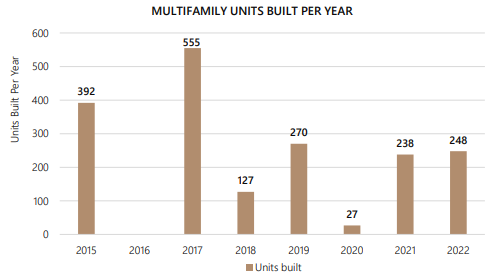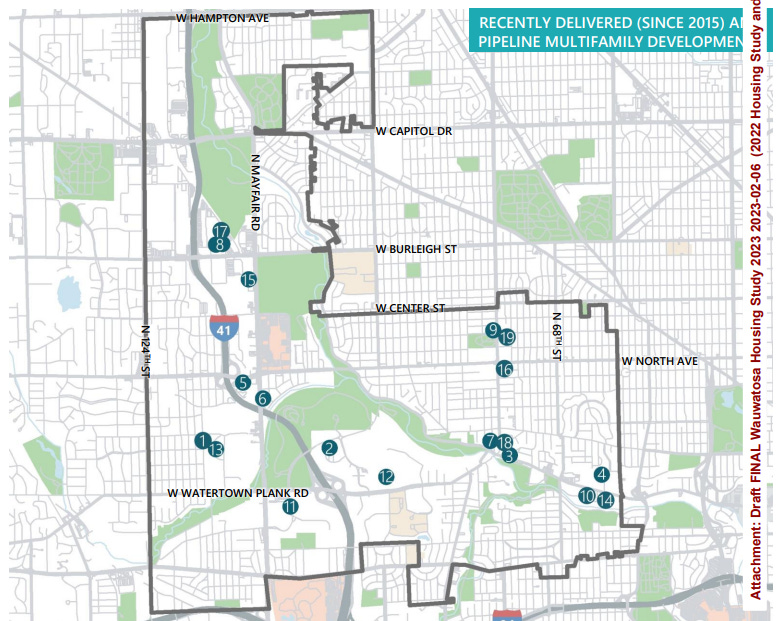Common Council hears presentation on Wauwatosa's housing needs
City growing faster than anticipated, more discussion of "missing middle" housing.
I.
SB Friedman, a community and economic development consulting firm based in Chicago, presented the results of a new housing study for the city of Wauwatosa to the Committee of the Whole on Tuesday, February 7th. I previously wrote skeptically of this endeavor—it cost $70,000 and they’d just done one in 2016 that included a bunch of suggestions the Common Council had still yet to implement.
Nevertheless, the study was to provide a “foundation that will inform new or revised policies” and “recommendations that can be proposed for consideration and approval by the common council.” It included an analysis of demographic data from the U.S. Census, employment data, and housing market and supply trends. They also completed a survey of 1,500 residents from July through September of 2022, interviewed stakeholders, and held a workshop with community members to understand how much they liked their current residence, why they bought it, and what type of housing they felt was lacking in the city.
Some highlights:
→ The city added much more housing than the consultants thought we would. Since 2106, SB Friedman reported that the city has added over 1,800 new multi-family units with an additional 650 in development. Just over 300 of these new units are income restricted and almost 350 are age-restricted. In another part of the study, they report that Wauwatosa has a total of 13,000 total housing units, so this represents about a 16% increase.

This was way more than they projected in 2016 (my emphasis in bold):
The total number of units actually exceeded the housing demand we had in our 2016 study. So, we had projected that the 15-year demand for multi-family housing would be about 1,600 units and you've already exceeded that.
The location of these new developments is below:

→ The city has gotten larger and younger. Population also grew faster than projected, and the city has become younger, with the median age falling from 40 to 38 years old. You can also see this in the decline of households 45 years old or greater and the increase in households less than 45 years old.
→ Household size has increased. There has been a steady downward trend across the entire world in family size over several decades , but the household size in Wauwatosa has actually increased from 2.51 to 2.61 for owner-occupied household and 1.86 to 1.89 for renter-occupied households.
→ East Wauwatosa is wealthier than West Wauwatosa and less diverse. Maybe everyone knows. I thought it was interesting to see it on a map though.
→ Most people who work in Wauwatosa don't live here.
92% of Wauwatosa workers lived outside of the City. The remaining 8% lived and worked in Wauwatosa. This is an increase of approximately 550 people both living and working in the City compared to the 2016 study.
→ Housing has actually become more affordable for residents. A story you often hear is one of rising housing costs and increasing unaffordability. But one way to measure the affordability of housing is to look at the percentage of households in the city that spend more than 30% of their income on housing related costs. Households that spend more than this are considered “cost burdened.” And the percentage of cost burdened households in Wauwatosa has actually declined from 30% of households in 2016 to 26% of households in 2022. Within Wauwatosa, renters are more likely to be cost burdened than homeowners and, in fact, homeowners in Wauwatosa are among the least likely to cost burdened in comparison to surrounding communities.
II.
Despite SB Friedman’s 2016 projections for new housing being way off, they've updated their analysis and now predict that “Wauwatosa could grow by 3,300 new residents by 2040, requiring 1,500-2,200 new units.” It’s unclear to me why we should expect this projection to be more accurate than the previous one, and they don’t really describe how they come up with these numbers or how certain they are of them.
Also, their recommendations for dealing with this increased housing demand tended to include things the city was already doing and generally seemed kind of vague and obvious. They recommended things like, “Identify underutilized publicly-owned land” for development, “develop a zoning overlay to provide incentives for developers who build affordable and physically accessible housing,” and “create a local or regional land trust.” I’m not sure if the common council was expecting more here.
They did report, based on the results of their community survey and workshops, that residents would like to see more housing that’s affordable to teachers, hospital staff, and city employees; more housing for seniors; realistically priced starter homes for young families; and more condos, townhomes, and other “missing middle” housing types like triplexes, fourplexes, and cottage courts. (see section III of this article for some discussion).
Most of the conversation following the presentation focused on this “missing middle” housing. Ald. Margaret Arney asked how the city could “make it make sense for developers to create that missing middle housing?”
Lance Dorn, the representative from SB Friedman, essentially suggested finding a developer and offering them money.
The challenge is there aren’t a lot of developers who do focus on this type of development. It’s a very specialized skill set. There’s sort of a limited number of players in this world. And often times it ends up being folks who have more of a connection to the community or local folks who are trying to advance the community’s goals.
Our recommendation there would really to be proactive in terms of identifying who’s active in this space. But you also have to couple a proactive outreach with really making the case of why development of this type should occur in Wauwatosa. And also bringing forth, potentially, any sites that would be appropriate. If you’re able to contribute those into a project, that makes the project more financially feasible. Or also bringing forth other sorts of incentives whether it be TIF money or some other sort of investment.
Fran Rood, also representing SB Friedman on Tuesday, suggested the city look at its “regulatory framework and [make] sure that both the development approval process and also zoning are really set up so that folks can develop this type of housing by-right.”
Ald. Joseph Makhlouf thought the city should be putting more money towards these types of projects rather than handing it off to big developers to build giant residential apartment buildings. “If we get the right developers that are not looking for the real high rates of return on their developments then we can make great advances on that.”
Ald. Arney asked: “So are you pretty much saying that traditional developers are not going to make money on missing middle housing?”
Mr. Dorn kind of agreed.
Mayor Dennis McBride added that the city is already going down this road with a local architecture firm that is interested in building these types of sites and suggested that the common council and the community “follow what the CDA [Community Development Authority] is doing because we’re moving in that direction.”
One idea I’ve tried to draw attention to in various, small ways since I started writing, is that regulations are costly. If you hate TIF financing and think they mostly serve as handouts to giant developers, if you’d like to see small architectural firms take on more projects in Wauwatosa, if you’d like to see more apartment buildings that aren’t ugly 5-over-1s, or if you’d just like to see more apartment buildings or housing period, then you should consider ways to reduce the costs of doing the things you’d like to see more of.
Big developers have lots of staff and work on many projects simultaneously. If one proposal gets nixed by the Common Council, they have others they can pursue. If they need to alter their plans because the Design Review Board didn’t appreciate their choice of exterior siding material or the footprint of their parking garage, they can afford to go back to the drawing board. Big firms dominate in industries with complex, bureaucratic barriers to entry because they’re the only ones that have large enough economies of scale to cover the fixed costs and uncertainties involved in shepherding a building project through a multi-year approval process.
A local government doesn’t have much control over the cost of lumber or labor but it does have control over the time it takes and the uncertainty involved in getting permission to build things, and it does have control over the constraints under which those things are built. Making the zoning code more amenable and removing hurdles to approval (common council votes, design review board meetings and revisions, etc.) makes these projects more profitable by reducing the costs involved in getting them off the ground in the first place.








So, did the taxpayers get their money's worth with this consultation that cost $70k? I like your suggestion that the city remove some of the bureaucratic barriers that developers face so smaller businesses would find a project profitable rather than the city seeking out developers and offering incentives to build the middle housing we are seemingly lacking. As an aside, we couldn't donate $5k to help Tosans pay their medical bills, but can hand over $70k for a questionably necessary consult.
Is there any room in the discussion for “why does the government need to be involved in this at all, and market forces that built 99% of the housing will take care of additional housing when demand and economics align for private investors?”